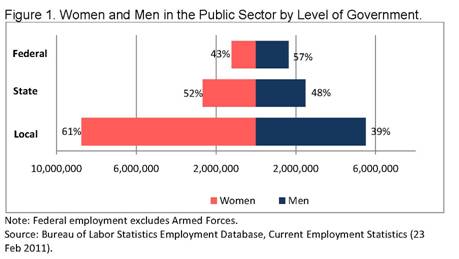What’s at Stake for Women Workers in Wisconsin and Beyond
The budget battles in Wisconsin, Indiana, and across the Midwestern United States have inspired a barrage of commentary about what the successful passage of the proposed state laws to strip public sector unions of their collective bargaining power would mean for public sector workers (not good), black workers (really not good), and the future of the labor movement (really, really not good). Another group with a significant stake in the outcome of these debates over public sector union bargaining power is women.
First, let’s review a few facts about women and labor unions in general. Although unionized women earn more than non-unionized women on average and have access to more benefits, such as paid leave and health insurance, public sector employees are actually paid less than their private sector counterparts, once their qualifications are taken into account. An IWPR report on job retention and low-income mothers found that union membership contributed to keeping moms on the job. In 2010, across race and ethnic groups, male union membership is lowest for Asian men, but Asian women have the highest membership rate of all groups of unionized women. Black men have the highest union membership, but black women are also more likely than white women to be unionized. Hispanic women have the lowest rate of union membership compared to other groups of women.
Although male workers are still the majority of union membership, the gap between unionized men and women over the last 25 years has narrowed considerably, with women representing the majority of new workers organized during that time. (For more on women and unions, visit IWPR’s Women in Unions initiative page.)
Public sector unions like the American Federation of State, County, and Municipal Employees (AFSCME) and the American Federation of Teachers, however, have a majority female membership (52 percent and 60 percent, respectively), which makes the legislative outcome of public sector union bargaining power of particular interest to women workers. Furthermore, as you can see in the figure below, women are 52 percent of the state public sector workforce and a whopping 61 percent of public workers at the local level (Figure 1).
If we focus on public sector employees at the local level, it becomes clear that women and their families will receive the brunt of the effects of these anti-union bills floating around state capitols in the Midwest. The most common occupation for local public sector women workers is elementary and middle school teachers (22 percent). The most common occupation for local public sector male workers? Police and sheriff’s patrol officers, a group whose union representatives would be excluded from proposed legislation.
This isn’t to say that men won’t be impacted by any effort to strip public sector unions of their bargaining rights. At the state level, three of the five most common public sector occupations for men are in teaching fields. Indeed, fire fighters and police unions have come out to protest in support of public sector employees–a blow to public sector union rights is a blow to all union rights.
As more women become breadwinners, women’s families will also feel the effects of any proposed legislation that affects women’s wages. In the U.S. workforce, four in ten women work in female-dominated professions. For example, elementary and middle school teachers–the occupation that is most common for local public sector women–are 81 percent female. Moreover, women earn less than men in 104 out of 108 of the occupational categories, including teaching, for which there is enough data to calculate the wage gap.
With so many women in the public sector at the state and local level, and with a proposed budget bill that would strip public sector unions—especially those representing female-dominated professions—of their bargaining rights, what is the outlook for women workers in Wisconsin and beyond? Not good.
Cross posted with author permission from the Institute for Women's Policy Research blog.

The views and opinions expressed in this post are those of the author(s) and do not necessarily reflect those of MomsRising.org.
MomsRising.org strongly encourages our readers to post comments in response to blog posts. We value diversity of opinions and perspectives. Our goals for this space are to be educational, thought-provoking, and respectful. So we actively moderate comments and we reserve the right to edit or remove comments that undermine these goals. Thanks!